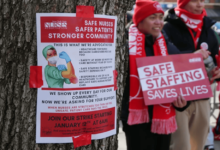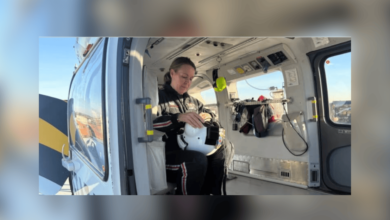Nurses Are NOT Punching Bags! Why We Must Report All Workplace Violence
A nurse and medical social worker were the victims of a double homicide inside the labor and delivery unit at Methodist Dallas Hospital in October 2022. This is just one of countless acts of violence against nurses and healthcare workers, but for me, it was the one that pushed me to take action.
In the wake of that tragedy, a close friend and I created the Red and Black Ribbon Campaign. The ribbon serves two purposes.
- First, to raise awareness of the increasing rates of healthcare worker violence. It creates opportunities to have crucial conversations.
- Second, to send a clear message that healthcare workers will not tolerate dangerous working conditions.
Workplace violence (WPV) is an act or threat of violence that ranges from verbal abuse to physical assault to death at the workplace, according to the National Institute for Occupational Safety and Health. Media attention tends to focus on workplace homicides, however, the vast majority of WPV are non-fatal, yet serious injuries. Healthcare workers accounted for 73 percent of all nonfatal workplace injuries and illnesses due to violence in 2018.
Violent incidents were once relegated almost exclusively to ERs and psychiatric units. These days all nurses are at risk regardless of healthcare setting. Even nurses who work in labor and delivery, home health and doctor’s offices are falling victim. It is important to remember everyone has a right to safe working conditions and employers are obligated to provide them.
Incidents of WPV remain underreported. Nurses should report all assaults and here’s why:
- It holds the attacker accountable. Remember this is a crime!
- It creates a tracking mechanism and paper trail. This may prove beneficial for any worker’s comp claims or legal action.
- It helps quantify violent incidents per specific hospital/employer. Healthcare organizations do not like the negative press. This holds employers accountable for providing safe working environments.
- A known risk factor for WPV is the perception that violence is tolerated and victims will not be able to report or press charges.
- It is empowering! You may be a victim, but you don’t have to stay a victim.
Nurses are often discouraged from reporting assaults by patients. Law enforcement may tell you the district attorney (DA) will not prosecute patient assaults. Whether or not the DA decides to charge an individual is beyond your control, but it should not deter you from reporting the crime.
This is what nurses should do if they are assaulted at work:
- Notify the charge nurse immediately.
- Go to the ER for treatment if needed. Go through worker’s comp – this is a workplace injury.
- Notify your manager.
- Notify the provider and social worker if it was a patient who assaulted you.
- Notify security.
- Fill out an incident report. Note – some organizations have additional reporting through the security department. If that is the case, submit both an incident and security/violence report.
- Ask any witnesses to write a statement for you.
- Take pictures of any visible injuries. Continue taking daily pictures as it heels.
- Contact law enforcement and make a police report. They may come to your work to take the statement or you may have to go to the police station (some places allow you to submit reports online).
- You should take time off to process what has happened.
- Seek out trauma-crisis counseling, critical incident stress debriefing, or with your organization’s EAP counselor.
- Keep copies of everything at home (not in your work email). Send summary emails of any verbal conversations to document.

Following an incident, nurses are often asked by management, “What could you have done differently?”, by managers. I recommend nurses turn the tables and ask, what could YOU have done differently to protect your employees?
Retaliation of any kind for reporting workplace safety issues is illegal. You can report retaliation to the National Labor Relations Board (NLRB) and Occupational Safety and Health Administration (OSHA). You can find direct reporting links on nurseerica.com
Nurses around the world are coming together to draw awareness to workplace violence against healthcare workers by wearing red and black ribbons. Many are making their own by tying red and black ribbons together! My red and black ribbon enamel pins are one way to spread awareness about violence against healthcare workers and to show unity and are available on my Etsy shop. We are stronger, together!
@the.nurse.erica Come out and support. Hope to meet you there. #fyp #foryourpage #nurse #safestaffingsaveslives #iamtristin #thenurseerica #wearealltristin ♬ original sound – TheNurseErica







